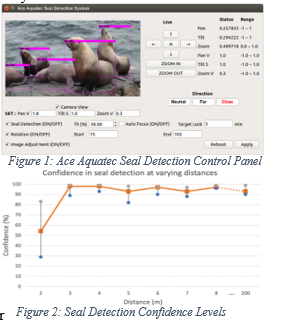AN ARTIFICIAL INTELLIGENCE-POWERED ACE AQUATEC SEAL DETECTION SYSTEM: REAL-WORLD EXPERIMENTAL DESIGN AND VALIDATION
Ace Aquatec Ltd is at the forefront of developing innovative products that promote fish welfare and sustainability in Aquaculture. One of the many products currently in development aims to deter seal s from fish farms in a humane, sustainable way. Seals are one of the most prevalent predators on fish farms, causing physiological and psychological damage to fish, as well as damaging the nets. Ace Aquatec
developed and deployed acoustic deterrent devices (ADDs) across farms which effectively prevented seal attacks. However,
recent policy changes in Scotland saw the removal of ADDs due to concerns over the noise pollution and harm caused to marine species. In response, Ace Aquatec has developed the first seal detection system which is designed to work in tandem with current deterrent systems. These trigger cameras accurately identify seals and instruct the deterrent systems to turn on only when necessary .
Figure 1 : Ace Aquatec Seal Detection C ontrol Panel
In response, Ace Aquatec has developed a first-of-its-kind artificial intelligence (AI)-driven seal detection system which is designed to work in tandem with conventional deterrent systems . The seal camera software benefits from a range of movement capabilities (see Figure 1). Using a PTZ degree camera, the system automatically identifies and tracks the movements of seals in a 125664m2
circular area. The system can also operate at night by applying night vision image adjustment, ensuring that sites have 24/7 protection.
Figure 2 : Seal Detection Confidence Levels
The functionality and accuracy of the system was tested under varying conditions: changes in light, distance to the camera, movement and false positives. By displaying seal images around the test area, it was found that the system successfully identifies seals under these changes and can distinguish between seals and other animals/objects. Figure 2 shows that the confidence increases to 99% as the distance is increased. In operation, this means that the system will be able to detect seals at a large distance and track its approach to the farm. Only when it has crossed the boundary into the farm will it trigger the ADDs.
Future development will include the detection of other significant species. For example, facial recognition can be added to aid with site security and the identification of other species may be of interest for the purpose of environmental/wildlife surveys being conducted in the area.
This research is supported by Innovate UK funded Knowledge Transfer Partnership (KTP) grant with Ace Aquatec (KTP grant no. 1026904).
